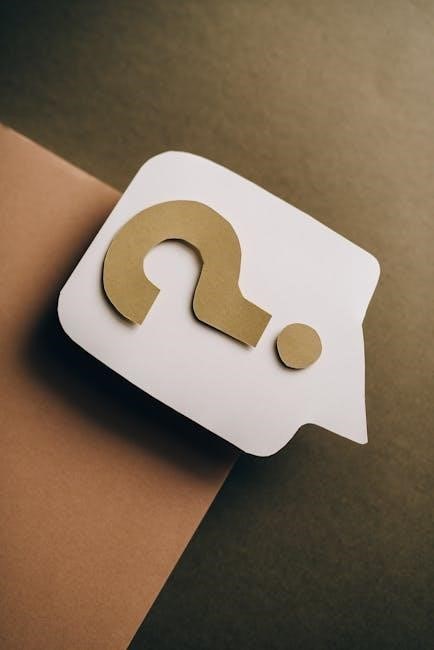guiding question
Guiding questions introduce students to topics, using
- ordered lists
to explore ideas and encourage conversation between student and teacher, resulting in a fundamental sense of understanding and learning objectives clearly.
Definition of Guiding Questions
Guiding questions are defined as open-ended questions that encourage students to think critically and explore ideas in depth, using a variety of methods such as discussions, debates, and research to arrive at a deeper understanding of the topic.
These questions are typically designed to be thought-provoking and allow students to consider different perspectives and opinions, promoting a sense of curiosity and inquiry.
Guiding questions can be used in a range of educational settings, from classrooms to online learning environments, and can be adapted to suit different age groups and learning styles.
By using guiding questions, teachers can help students develop important skills such as critical thinking, problem-solving, and communication, which are essential for success in all areas of life.
Additionally, guiding questions can help to create a sense of community and collaboration in the classroom, as students work together to explore and learn about a particular topic.
Overall, guiding questions play a vital role in promoting student learning and understanding.

Role of Guiding Questions in Education
Guiding questions play a crucial role in education by providing a framework for instruction and learning.
They help teachers to plan and deliver effective lessons, and enable students to develop a deeper understanding of the subject matter.
Guiding questions also facilitate the integration of different subjects and topics, promoting a more holistic approach to education.
In the classroom, guiding questions can be used to introduce new topics, stimulate discussion, and encourage critical thinking.
They can also be used to assess student learning and understanding, providing valuable feedback for teachers.
By incorporating guiding questions into their teaching practice, educators can create a more engaging and effective learning environment.
This approach can help to improve student outcomes, increase motivation, and foster a love of learning that extends beyond the classroom.
Guiding questions are a powerful tool in education, and their use can have a significant impact on student learning and achievement.

Characteristics of Guiding Questions
Guiding questions have key characteristics, including clarity and purpose, using
- unordered lists
to outline specific issues and topics clearly and concisely always.
Clarity of Guiding Questions
Guiding questions are clear and concise, avoiding ambiguity or vagueness, to ensure that respondents or learners understand the specific issues or topics under consideration, using
- ordered lists
to outline key points;
The clarity of guiding questions is essential to facilitate effective learning and understanding, enabling students to focus on the topic at hand and explore ideas in a logical and methodical manner, with
- unordered lists
providing additional context and supporting information.
Clear guiding questions also help to establish a sense of direction and purpose, guiding the learning process and ensuring that students stay on track and achieve their learning objectives, with
paragraphs
providing detailed explanations and examples to illustrate key concepts.
By using clear and concise language, guiding questions can help to promote critical thinking and problem-solving skills, enabling students to develop a deeper understanding of the subject matter and apply their knowledge in practical and meaningful ways, using
headings
to organize and structure the content.
Overall, the clarity of guiding questions is critical to their effectiveness, and educators should strive to create questions that are clear, concise, and unambiguous, using
to present complex information in a clear and concise manner.
Purpose of Guiding Questions
The purpose of guiding questions is to provide direction and focus for learning, helping students to understand the topic and achieve their learning objectives, using
- ordered lists
to outline key concepts.
Guiding questions are purpose-driven and align with the overarching goals or objectives of a project, study, or discussion, with
- unordered lists
providing additional context and supporting information.
The purpose of guiding questions is to encourage critical thinking and problem-solving skills, enabling students to develop a deeper understanding of the subject matter and apply their knowledge in practical and meaningful ways, using
paragraphs
to provide detailed explanations and examples.
Guiding questions also help to create a sense of curiosity and inquiry, motivating students to explore and learn more about the topic, with
headings
used to organize and structure the content, and
used to present complex information in a clear and concise manner, facilitating effective learning and understanding.

Examples of Guiding Questions
Guiding questions include what, how, and why, using
- unordered lists
to explore ideas and topics, facilitating learning and understanding with clear examples and explanations always.
Essential Questions and Guiding Questions
Essential questions and guiding questions are related but distinct, with essential questions being broad and guiding questions being more specific, using
- ordered lists
to explore ideas and topics. Guiding questions assist teachers in planning instruction, providing focus and direction, and encouraging conversation between student and teacher. The relationship between essential and guiding questions is important, as guiding questions help to answer essential questions, and essential questions provide context for guiding questions. By using
- unordered lists
to explore ideas and topics, teachers can help students develop a deeper understanding of the subject matter, and guiding questions can help to facilitate this process, resulting in a more comprehensive and engaging learning experience for students, with clear examples and explanations always, and using various
paragraphs
to organize the content. Guiding questions create a goal for learning and help students develop critical thinking skills.
Guiding Questions in the Classroom
Guiding questions are used in the classroom to encourage critical thinking and facilitate learning, with teachers using
to organize and present information. By incorporating guiding questions into lesson plans, teachers can help students develop a deeper understanding of the subject matter, and create a more engaging and interactive learning environment. Guiding questions can be used in various ways, such as in
- definition lists
to explore key terms and concepts, or in
- unordered lists
to brainstorm and generate ideas. Teachers can also use guiding questions to assess student understanding and adjust instruction accordingly, using
to collect feedback and evaluate student progress. By using guiding questions in the classroom, teachers can create a more student-centered and inquiry-based learning environment, where students are encouraged to explore and discover new ideas and concepts, and develop a love of learning that extends beyond the classroom. Guiding questions help students develop at least three questions to explore related topics.

Benefits of Guiding Questions
Guiding questions create a goal for learning, using links to focus and direct student inquiry and understanding, promoting critical thinking and academic success always in educational settings.
Creating a Goal for Learning
Guiding questions play a crucial role in creating a goal for learning, as they help students focus on specific objectives and outcomes. By using guiding questions, teachers can ensure that students are aware of what they need to learn and achieve, and can direct their efforts accordingly. This involves setting clear and measurable goals, and providing students with the necessary support and resources to achieve them. Guiding questions can be used to introduce new topics, and to help students explore and understand complex ideas and concepts. They can also be used to encourage critical thinking and problem-solving, and to promote deeper understanding and learning. By creating a goal for learning, guiding questions help students to stay motivated and engaged, and to develop a sense of purpose and direction in their learning. This is essential for academic success, and for developing a love of learning that will last a lifetime.
Encouraging Critical Thinking
Guiding questions are an effective way to encourage critical thinking in students, as they prompt students to think deeply and critically about a topic. By using guiding questions, teachers can help students to develop their analytical and problem-solving skills, and to learn to evaluate information and make informed decisions. Guiding questions can be used to stimulate discussion and debate, and to encourage students to consider different perspectives and points of view. This helps students to develop a more nuanced and sophisticated understanding of complex issues, and to learn to think creatively and critically. Guiding questions can also be used to help students to identify patterns and relationships, and to make connections between different ideas and concepts. By encouraging critical thinking, guiding questions help students to develop a range of essential skills that are valuable in all areas of life, including academic, professional, and personal pursuits, and to become more independent and self-directed learners.
Guiding questions conclude learning experiences, using
- unordered lists
to summarize key points and reinforce understanding and knowledge retention effectively always.
A summary of guiding questions reveals their importance in education, using
- unordered lists
to outline key characteristics, such as clarity and purpose, and their role in creating a goal for learning and encouraging critical thinking.
Guiding questions are essential in planning instruction and deciding what to include, and they provide focus and direction in exploring topics, resulting in a fundamental sense of understanding and learning objectives clearly.
The use of guiding questions in the classroom can be beneficial, as they encourage conversation between students and teachers, and help students develop their own answers and perspectives, using
- ordered lists
to explore ideas and concepts.
Overall, guiding questions play a crucial role in education, and their effective use can lead to improved learning outcomes and a deeper understanding of subject matter, using
- definition lists
to define key terms and concepts.
By using guiding questions, teachers can create a supportive learning environment that encourages critical thinking and exploration, and helps students achieve their learning goals, using
to organize and summarize information.
